|
|
Yogasans for managing Metrorrhagia
This condition is characterized by irregular and heavy bleeding between
menstrual periods.
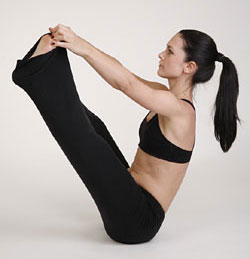 What causes it? What causes it?
Metrorrhagia can be caused by a
hormonal imbalance.
The start of menstruation during puberty and the length and regularity of the
menstrual cycle is controlled by hormones produced in an area of the brain
called the hypothalamus, as well as by the pituitary and adrenal glands. The
type of hormonal imbalance that causes metrorrhagia can occur when hormone
medications, such as
birth
control pills, are used improperly. Many causes of metrorrhagia are related
to the cervix or uterus, including
cancer, inflammation or
infections,
non-cancerous polyps (growths), scar tissue in the uterus (adhesions), and the
growth of uterine tissue outside the uterus (endometriosis). Metrorrhagia can
also be caused by miscarriage, a
pregnancy that is developing in the fallopian
tubes (tubal or ectopic pregnancy), the use of an intrauterine device (IUD) for
birth control, or chronic medical problems such as
thyroid disorders,
diabetes,
and blood-clotting disorders.
Uttanasana (Intense forward stretch)
This is a less strenuous version of the classic pose that helps beginners and
those with stiff backs to achieve the final forward stretch. There are five
variations of the final pose. Practice the one you find most comfortable, and
which suits your needs the best. This is both a calming and recuperative
asana, which rests and energizes the heart and lungs.
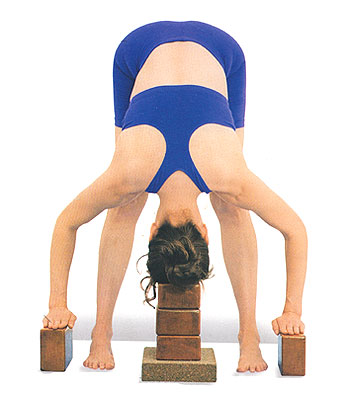
-
Stand in
Tadasana. Separate your legs to a distance of 30cm (1ft). Keep your
feet parallel to each other, with the toes pointing forward. Pull up your
kneecaps.
-
Inhale and raise your arms toward the ceiling, your palms facing forward.
Push your spine up.
-
Bend from the waist toward the floor. To increase the stretch of your spine,
vital for correct practice, press your heels down on the floor.
-
Rest the crown of your head on the blocks in front of you, and place your
palms on the blocks beside your feet. Pull in your kneecaps. Extend your
hamstrings and pull your inner legs upward. Feel one single stretch from the
crown of your head to your heels. Hold the pose for 1 minute.
Ardha Chandrasana (Half moon pose)
In sanskrit, ardha means "half", while Chandra translates as "moon". In this
asana, your body takes the shape of a half moon. Regular practice enhances
your span of concentration. It also improves co-ordination and motor reflexes.
The intense stretch it gives to the spine, strengthens the paraspinal muscles,
keeping the spine supple and well-aligned.
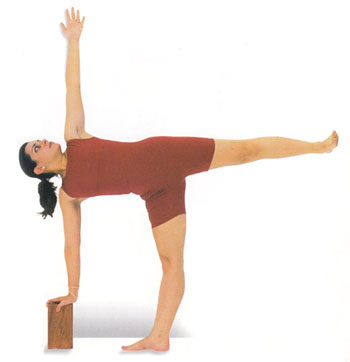
-
Stand in Tadasana. Place a block on its short side against the wall. Inhale,
spread your feet 1m (3.5ft) apart. Raise your arms to shoulder-level.
-
Turn your right foot out to the right, parallel to the wall, and turn your
left foot in, slightly to the right. Bend your right knee, and place the right
palm on the block. Raise your left arm.
-
Straighten your right leg. Raise your left leg, until it is parallel to the
floor. Keep your left arm stretched up, in line with the right arm. The back
of your left hand should touch the wall.
-
Look up at your left thumb. Keep your weight on the right foot, thigh, and
hip, not on your right palm. Hold the pose for 20 seconds. Repeat the pose on
the other side.
Prasarita Padottanasana (Intense leg stretch)
Prasarita means "stretched out" or "spread out", while pada means "leg" or
"foot". This asana gives an intense stretch to your legs. The torso is
inverted in the pose, and the head rests on the floor, or on a block or a
bolster. This restful and recuperative asana is usually practiced toward the
end of the standing pose cycle, just before Salamba
Sirsasana. Practicing the
asana cools the body and brain, and gives you a feeling of tranquility and
repose.

-
Stand in Tadasana. Place your hands on your
hips, with your thumbs on your
back and your fingers on the front of the hips. Inhale, and spread your feet
1.2m (4ft) apart. Your feet should be parallel to each other, the toes
pointing forward. Press the outer edges of your feet to the floor. Keep your
back erect.
-
Exhale, and lift both kneecaps. Bend forward, extending your spine, and
bring your torso down toward the floor. Look up as you bend to ensure that
your back is concave. Take both hands off your hips, and lower them to the
floor. Place your palms flat on the floor with your fingers spread out.
-
Widen your elbows, keeping your palms flat on the floor. Place the crown of
your head on the floor, between your palms. Push your sternum forward and draw
the abdomen in. Move the thighbones and groin back to reduce the pressure on
your head. Stay in the pose for 1 minute.
Upavista Konasana (Seated wide-angle pose)
This version of Upavista Konasana is adapted to help beginners and those with
stiff backs to stretch the legs out to the sides, omitting the forward bend of
the original asana. The pose gets its name from the Sanskrit words upavista,
which means "seated", and kona, which translates into "angle". This asana
relaxes stress-related tension in the
abdominal muscles.

-
Sit against a wall. Then sit in
Dandasana with your
shoulders and back
touching the wall. Keep your back erect. Sit on your buttock bones. Place your
palms on the floor, beside your hips, fingers pointing forward. Look straight
ahead.
-
Press your palms down on the floor to push your torso upward. Exhale, and
spread your legs as far apart as possible. Use your hands, one by one, to help
you to push your legs even further out to the sides.
-
Move your hands behind your buttocks, and place both palms on the floor.
Press your heels and thighs down on the floor. Lift your waist and the sides
of your torso. Rotate your thighs to the front so that the kneecaps face the
ceiling. Shift your weight from the buttocks to the pelvic bone. Stretch each
leg from thigh to heel. Hold the pose for 30-40 seconds.
Supta Baddhakonasana (Reclining fixed angle pose)
Sputa means "reclining", baddha means "fixed", while kona translates as
"angle". This is a very restful asana that can be practiced even by those who
have had bypass surgery. It gently massages the heart
and helps open blocked
arteries. The pose also improves blood circulation in the
abdomen,
massaging
and toning the abdominal organs.
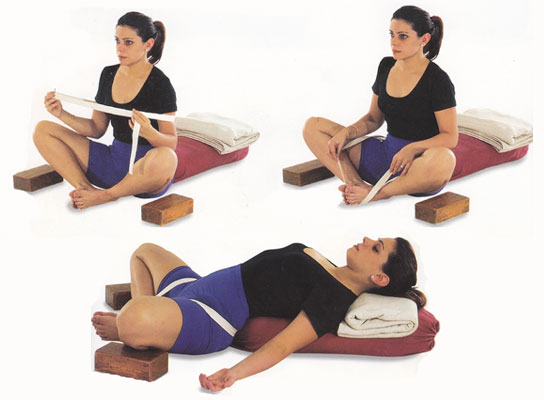
-
Sit in Dandasana. Place a bolster behind you, its short end against your
buttocks, and place a folded blanket on its far end. Place 2 wooden blocks on
their broad sides on either side of your hips. Bend your knees, and join the
soles of your feet together. Draw your heels toward your groin. Buckle the
belt and loop it over your shoulders.
-
Bring the belt down to below your waist. Pass it under both feet to stretch
it over your ankles and the insides of the thighs. Move your feet closer to
your groin. The belt should feet neither too tight nor too slack, so adjust
the buckle accordingly. Make sure that the end of the bolster touches your
buttocks. Position a block under each thigh.
-
Place your elbows on the floor, and lower your head and back onto the
bolster. Make sure that the bolster comfortably supports the length of your
back and your head. Your spine should be on the centre of the bolster. Stretch
your arms out to the sides, with the palms facing the ceiling. Relax, and
extend your groin out to the sides. Feel the expansion of the pelvis, and the
release of tension in your ankles and knees. Initially, stay in the pose for 1
minute. With practice, increase the duration to 5-10 minutes.
Janu Sirsasana (Head-on-knee pose)
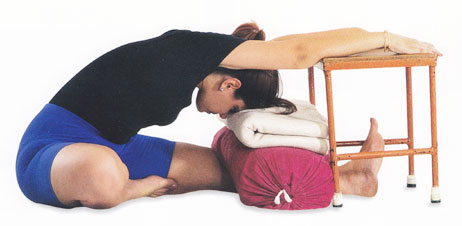
-
Place a low stool on the floor. Sit in Dandasana with your feet through it.
Sit on your buttock bones. Press your palms to the floor beside your hips and
straighten your back. Bend your left leg and bring the heel to your groin.
Your toes should touch your right thigh and your legs should be at an obtuse
angle. Push the bent knee as far back as you can. Keep your right leg
absolutely straight. Place the bolster across your right calf, and place a
folded blanket on top of it for added height.
-
Exhale, and bend forward from the base of your spine, not from the shoulder
blades. Stretch your arms over the bolster and rest your palms on the stool.
Keep your left knee pressed to the floor.
-
Push your torso forward and hold the far edge of the stool. Stretch from the
groin to the navel. Do not allow your abdomen to contract as you bend forward.
Rest your forehead on the blanket and close your eyes. Exhale slowly to
release the tension in your neck and head. Stay in this position for
approximately 1 minute. Repeat the pose on the other side.
Setubandha Sarvangasana (Bridge pose)
The word setu means "bridge", bandha translates as "formation", and sarvanga
means "entire body". In this asana, the body arches to take the shape of a
bridge. The chinlock in the asana calms the flow of thoughts and soothes the
mind. The pose sends a fresh supply of blood to the brain, resting and
revitalizing the mind and body.
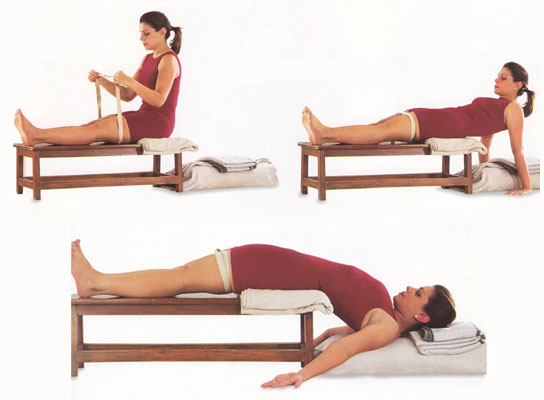
-
Place a folded blanket on one end of the bench. Place a bolster on the floor
in line with the bench, and touching one end of it. Place a folded blanket on
the bolster. Then sit on the blanket on the bench, with your legs stretched
out. Place a yoga belt under your thighs and bind it round the middle of your
thighs.
-
Exhale, and lower your back toward the bolster. Press each palm down on the
floor on either side of the bolster, your fingers pointing forward. Both arms
should support your upper back. Keep your thighs, knees, and feet close
together, your heels on the bench, and your toes pointing upward. Lower your
arms to the floor.
-
Slide further down, until the back of your head and your shoulders rest on
the bolster. Straighten your legs, keeping your feet together. Stretch the
heels and toes away from the torso to increase the stretch of the legs. Extend
your arms to the sides on the floor, with the palms facing the ceiling. Hold
the pose for 3 minutes. Gradually increase the time to 5-8 minutes.
Related Links
|
|
|
|
|









